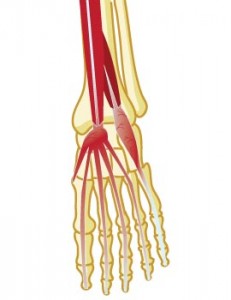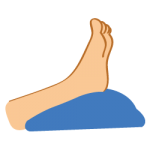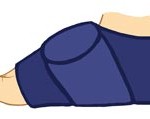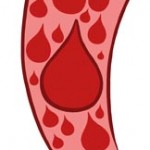 Tendonitis implies to inflammation of the tendon whereas tendinopathy is a more general term which refers to the degeneration of the tendon.
Tendonitis implies to inflammation of the tendon whereas tendinopathy is a more general term which refers to the degeneration of the tendon.
As with many types of tendonitis, extensor tendonitis is an overuse injury. Badly fitting shoes or shoes that are laced too tightly causing pressure over the top of the foot. Running up hill, means the foot has to be lifted slightly higher on each stride. Running downhill the muscles work eccentrically, which places stress on the extensor tendons the same way as can running on ice or slippery surfaces.
Extensor tendonitis most commonly occurs by having the laces of your shoes too tight and having the foot rubbing against the laces causing pressure points. It tends to affect people who spend long periods of time on their feet, people walking or running on uneven surfaces or up and down hill. Having pain on the top of your foot when you curl your toes is a good indication that your extensor tendons are inflamed. Most people notice swelling over the top of the foot as well as bruising. The top of the foot will be tender to the touch making it uncomfortable to wear shoes.
Having tight calf muscles as well as people with high arches add extra strain on the tendons and pressure on the top of the foot that significantly increases the chance of developing tendonitis.
A change in training methods, particularly running up hill, or on a treadmill can also place more stress on the extensor tendons on the top of the foot.
GET BACK IN THE GAME SOONER!
Tendonitis isn’t fun. Here are some simple steps to help you get back on your feet quickly.
Ice and compression. Ice is very important to reduce swelling, as is compression. Combining these two will quickly get rid of any inflammation that is tendonitis is causing. Icing as many times as possible in 20 minute increments is important for the first couple days, and lessening treatments each day as you feel necessary.
 Pain killers should only be taken when inactive. Using a pain reliever or anti-inflammatory to help you get through the day not only will cause you to injure yourself further, you won’t know that you’ve hurt yourself until the effects of the pulls have worn off. It is strongly recommended to “tough it out” during the day so that way you’re aware of what your body is capable of handling.
Pain killers should only be taken when inactive. Using a pain reliever or anti-inflammatory to help you get through the day not only will cause you to injure yourself further, you won’t know that you’ve hurt yourself until the effects of the pulls have worn off. It is strongly recommended to “tough it out” during the day so that way you’re aware of what your body is capable of handling.
 Stay off your feet as much as possible. This will give your body time to heal, without constant stretching from walking on it. Crutches are recommended for a couple of days, to give your body a kick start in healing.
Stay off your feet as much as possible. This will give your body time to heal, without constant stretching from walking on it. Crutches are recommended for a couple of days, to give your body a kick start in healing.
Heat or physical therapy to stimulate blood flow. The best way to heal yourself is to ensure optimal blood flow is being targeted directly to the injury. Heating pads heat the surface – but will still increase blood flow mildly. Physical therapy will help stretch the muscles – depending on how much injury there is, this isn’t recommended right away. Whichever method you choose – optimal blood flow is the key.
Change the way you lace up your shoes. The ladder style as opposed to the cross pattern that’s widely used prevents less pressure over the extensor tendons which reduces pressure on the top of the foot by not allowing the laces to cross over the middle of the metatarsals.


[…] What we wear on our feet has a big impact on the health of our feet. Shoes that are too narrow, too tight or without enough support and protection frequently cause foot problems with the bones, muscles, ligaments and nerves. Shoes should ideally have a wide toe area, cushioned, flat soles and should be supportive but not tight. […]
[…] Extensor Tendonitis […]